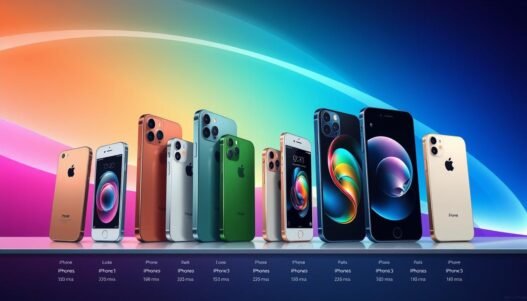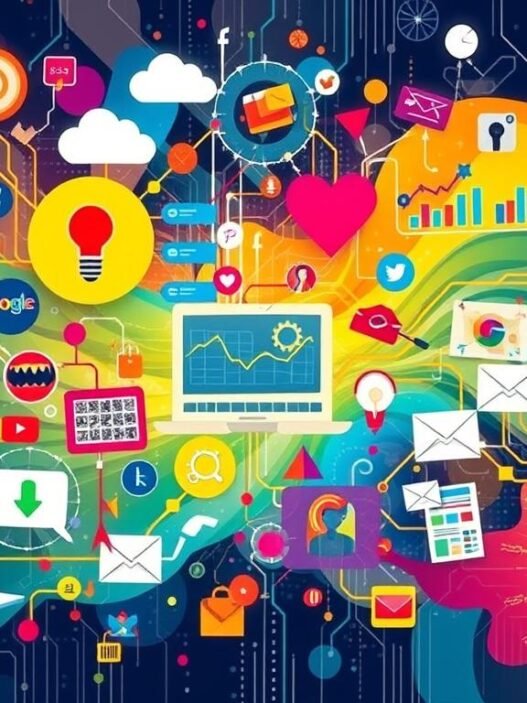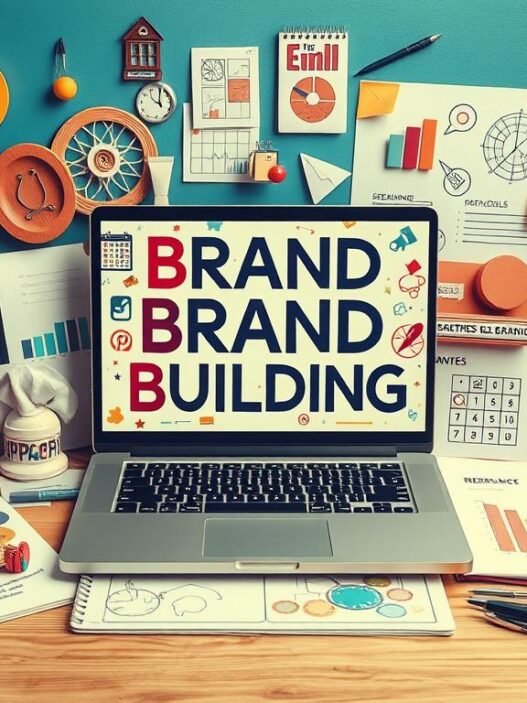Apple’s iPhone lineup is truly impressive, featuring nine models sold directly to consumers. Launching four models in fall 2024 and others dating back to spring 2022, it showcases a wide variety. This variety meets different preferences and needs, focusing on features like camera quality, display, durability, or price.
iPhone prices cover a broad spectrum. They range from the affordable iPhone SE (3rd gen) to the high-end iPhone 16 Pro Max. The comparison highlights evolution in storage, camera tech, and battery life. It also shows wireless improvements and other key features over time. iOS updates and ecosystem integration enhance the experience across all models.
Key Takeaways
- Apple’s iPhone assortment accommodates all types of users with a total of nine different models on offer.
- Variations in iPhone prices reflect a diverse range that aligns with the unique features of each model.
- Significant advancements in camera technology and display quality across the iPhone lineup.
- Options in iPhone storage capacities are extensive, going up to 1TB on selected models.
- iOS updates and the robust Apple ecosystem ensure seamless integration for an optimized user experience.
- iPhone durability and battery life have become more robust with the latest offerings, alongside fast-charge capabilities.
- Wireless capabilities have been enhanced with the inclusion of 5G and Wi-Fi 6 across the iPhone spectrum.
The Evolution of iPhone Features Over the Years
Since its launch in 2007, the iPhone has changed the world of mobile tech. It constantly breaks new ground with innovations. Features like the evolving iPhone camera, Face ID technology, and A-series chips are key milestones. They show Apple’s dedication to blending style, function, and strong performance in one device.
Advancements in Camera Technology
The iPhone’s camera has improved in amazing ways, exciting both pros and everyday users. The original iPhone had a simple 2 MP camera. Now, the latest iPhones boast advanced systems with computational photography. This leap is a big part of the iPhone’s story.
The move to computational photography changed how iPhones handle light and focus. Now, photos are brighter, clearer, and full of color.
The Emergence of Face ID
The iPhone X introduced us to Face ID technology. With advanced face recognition, it brought new levels of security and ease. It didn’t just make iPhones more secure; it inspired the entire industry to innovate.
Introduction of A-Series Processors
The A-series chips have been game-changers for smartphone performance. Starting with the A4 in the iPhone 4, Apple’s chips have become more powerful and efficient. The latest, the A16 Bionic, boosts graphics and AI processing. It’s part of Apple’s plan to improve every aspect of the iPhone experience.
With these advancements, Apple stays ahead in tech. It shapes how we use our gadgets day-to-day. This evolution from simple phones to complex smartphones shows Apple’s commitment to excellence and making customers happy.
Understanding iPhone Model Differences
Apple’s iPhone series keeps growing, offering a wide range for shoppers. Every new iPhone brings important upgrades, essential for making the right choice. This guide dives deep into the recent models, showing you what sets them apart, to help find the best phone for you.
We’ll look at the differences from the iPhone 14 to the iPhone 16 series. It’s key to know about storage sizes, camera quality, screen types, and how well each phone works. Apple promises better features with every new model, aiming to attract tech lovers and everyday users.
| Model | Release Year | Storage Options | Screen Type | Weight |
|---|---|---|---|---|
| iPhone 16 Pro Max | 2024 | 256 GB, 512 GB, 1 TB | OLED | 7.99 oz |
| iPhone 16 Pro | 2024 | 128 GB, 256 GB, 512 GB, 1 TB | OLED | 7.97 oz |
| iPhone 16 Plus | 2024 | 128 GB, 256 GB, 512 GB | OLED | 7.21 oz |
| iPhone 16 | 2024 | 128 GB, 256 GB, 512 GB | OLED | 6.00 oz |
| iPhone 15 Pro Max | 2023 | 256 GB, 512 GB, 1 TB | OLED | 7.09 oz |
| iPhone 15 Pro | 2023 | 128 GB, 256 GB, 512 GB, 1 TB | OLED | 7.07 oz |
| iPhone 15 Plus | 2023 | 128 GB, 256 GB, 512 GB | OLED | 6.67 oz |
| iPhone 15 | 2023 | 128 GB, 256 GB, 512 GB | OLED | 6.02 oz |
| iPhone 14 Pro Max | 2022 | 128 GB, 256 GB, 512 GB, 1 TB | OLED | 7.16 oz |
| iPhone 14 Pro | 2022 | 128 GB, 256 GB, 512 GB, 1 TB | OLED | 7.10 oz |
This detailed comparison highlights Apple’s drive for innovation. With improved displays and varied storage options, there’s something for everyone. This guide is here to simplify picking the perfect iPhone, ensuring you get the most out of its features.
Pricing Structure Across Different iPhone Models
When we dig into iPhone pricing, it’s clear there’s a model for everyone. Whether you need a budget iPhone or the top premium iPhone models, you’ll find what suits you.
The price of iPhones can change a lot between each model. The iPhone SE (2022) costs $429, offering high power in a small package. Meanwhile, the latest iPhone 16 Pro models begin at $1000. They come with the newest tech, like the A18 chip and better cameras.
This price comparison shows Apple’s approach to iPhone pricing.
| Model | Starting Price | Notable Features |
|---|---|---|
| iPhone SE (2022) | $429 | 4.7-inch Retina HD display, A15 chip, Touch ID |
| iPhone 14 | $599 | 6.1-inch Liquid Retina HD display, A14 chip, dual-camera system |
| iPhone 14 Plus | $699 | 6.7-inch Liquid Retina HD display, A14 chip, dual-camera system |
| iPhone 16 | $799 | 6.1-inch Super Retina XDR display, A18 chip, triple-camera system |
| iPhone 16 Plus | $899 | 6.7-inch Super Retina XDR display, A18 chip, triple-camera system |
| iPhone 16 Pro | $999 | 6.1-inch Super Retina XDR display with ProMotion, A18 Pro chip, Action button |
| iPhone 16 Pro Max | $1099+ | 6.9-inch Super Retina XDR display with ProMotion, A18 Pro chip, Action button |
This table makes it clear that Apple has a phone for every budget and need. If you’re saving money, the iPhone SE and iPhone 14 are good picks. But if you want the latest tech, consider the iPhone 16 Pro models.
iPhone Storage Options: How Much Do You Really Need?
Picking the right iPhone storage capacity is key to making the most of your phone. Whether you love lots of photos and videos or just use your phone lightly, knowing how much space you need is a big help. iPhones offer a range from 64GB to a huge 1TB to meet everyone’s needs.
Comparing Storage Capacities and Prices
| Model | Storage Options | Price Increase Per Option |
|---|---|---|
| iPhone SE | 64GB | Base Price |
| iPhone 14 Pro | 128GB, 256GB, 512GB, 1TB | $100 to $200 for each step up |
| iPhone 16 Pro Max | 1TB | Highest Price |
For many, 128GB or 256GB strikes the perfect balance between cost and space. But if you’re into high-res videos or big apps, think about 512GB or even 1TB. Especially with models like the iPhone 16 Pro Max. It’s all about what you do with your phone and what you can afford, plus planning for the future.
Effectiveness of Cloud Services and iPhone Storage Management
Cloud services have changed how we handle smartphone storage management. Take iCloud, for example, with plans from 5GB to 2TB. It’s a great way to keep your stuff without filling up your phone. Plus, 200GB for $2.99 a month is a small price for a tidy device. And let’s not forget the ‘Optimize iPhone Storage’ feature that keeps only what you need on your phone, and puts the rest in the cloud.
If you don’t like monthly bills, buying an iPhone with more space might save money over time. And now, external storage drives work better with new iPhones, giving you another option to manage space.
Choosing more phone storage or using cloud services, both make managing digital files easier. Think about how you use your phone for personal or work stuff before you buy. This will help you make the best choice.
A Closer Look at iPhone Display Technology
In the world of smartphones, iPhone display technology is always ahead. It changes how we see things. Moving from OLED vs. LCD screens was big. Newer iPhones use OLED because it has better colors and is brighter.
The ProMotion feature in new models like the iPhone 14 Pro Max is cool. It makes the screen smooth and fast, changing the refresh rate up to 120Hz. This makes the phone easier to use and saves battery life.
Having a high pixel density means pictures look sharp. The iPhone 14 Pro Max shows images in great detail. With a 2796 x 1290 Full HD+ display, it’s clear for videos and reading.
When we compare peak brightness, newer iPhones shine, literally. The iPhone 14 Pro Max can go up to 2,300 nits. That means you can see the screen clearly, even in bright sunlight.
The table below shows how far iPhone screens have come. It lists key features of different models. This shows the progress in technology and how it makes using the iPhone better:
| Feature | iPhone 13 Pro Max | iPhone 14 Pro Max |
|---|---|---|
| OLED vs. LCD | OLED | OLED |
| ProMotion | 10 Hz to 120 Hz | 10 Hz to 120 Hz |
| Screen Resolution | 2778 x 1284 | 2796 x 1290 |
| Pixel Density | 458 ppi | 460 ppi |
| Peak Brightness | 1,200 nits | 2,300 nits |
| HDR Brightness | 1,200 nits | 1,590 nits |
The comparison shows us more than just look and feel. iPhone display technology makes the phone better to use in many ways. It’s about beauty and making the phone work better for you.
Breaking Down iPhone Camera Capabilities
The iPhone camera has changed the way we take and see photos. Early models were simple, but now we have the advanced iPhone 16 camera. Each new iPhone brings better features for all types of photographers.
From iPhone SE to iPhone 16: Camera Enhancements
The iPhone SE (2020) started with a 12MP Wide camera. It was affordable. Then, the iPhone 12 series added dual 12-megapixel cameras and a 7-element lens for more light. The iPhone 12 Pro and Pro Max introduced three cameras and a LIDAR sensor for better depth and low-light shots.
The iPhone 16 series hit a high mark in camera tech. It offers up to 48MP for ultra-clear photos. These phones use smart tech to enhance textures and details. They also support Apple ProRAW for better editing without losing quality.
Video Recording Features and Quality
iPhone 16 improves 4K video with 60 fps on all cameras. It has better range and stabilization. New modes, like Night mode Time-lapse, allow for amazing low-light videos. It’s like making cinema-quality videos on your phone.
| Feature | iPhone 12 Pro Max | iPhone 16 |
|---|---|---|
| Main Camera Resolution | 12 MP | 24/48 MP |
| Lens Aperture | f/1.6 | f/1.6 |
| Optical Zoom | 2.5x | 3x |
| Digital Zoom | 12x | 10x |
| Low Light Feature | Sensor-shift OIS | Night mode |
iPhone camera systems keep getting better. From close-ups to portraits, smart techniques help iPhones lead in mobile photography. This invites users to capture and share amazing moments.
Exploring iPhone Durability and Build Quality
Apple always focuses on how strong and well-made iPhones are for its users. They find the perfect balance between looking good and lasting long. This is done through picking the best materials and construction methods.
Materials Used in iPhone Construction
Since the beginning, iPhones have used materials that look great and are strong. They started with plastic and aluminum but now use stainless steel and titanium in the Pro models. The new Ceramic Shield also promises better protection from drops.
Water and Dust Resistance Across Models
Apple keeps making iPhones that last longer against water and dust. Each new iPhone is better protected from these elements. This makes them more convenient and durable for users.
Looking at different models shows a range of how well they can resist damage:
| Model | Water Resistance | Durability Features | User Feedback on Durability |
|---|---|---|---|
| iPhone 12 and 13 | IP68 (up to 6 meters for 30 minutes) | Ceramic Shield, aerospace-grade aluminum, and surgical-grade stainless steel | Improved drop performance; better protection from elements |
| iPhone 15 Pro Max | N/A | Titanium design | Some reports of glass breaking, suggesting material choice could be better |
| iPhone SE (2022) | Can survive 6-foot drops | A15 bionic chip, tough glass | Very durable, great for everyday use based on reviews |
| iPhone 11 Series | IP68 (up to 4 meters for Pro and Pro Max) | Strong glass and aluminum build | Good at resisting water and minor drops |
Even with advanced engineering, the newest iPhones have had some issues, especially with the back glass. Despite using top materials like titanium and Ceramic Shield, there’s still room to make iPhones even stronger.
Comparative Analysis: Battery Life of iPhone Models
The battery life of iPhones has greatly improved over time. Specifically, the iPhone 14 series shows progress in battery size and how long they can play videos. These features are key for users who need a lot of power. We can learn a lot by comparing recent iPhone models with their competitors. We look at iPhone power efficiency and battery capacity comparison.
| Model | Battery Size (mAh) | Battery Life (Hours:Minutes) |
|---|---|---|
| iPhone 14 | 3,279 | 9:28 |
| iPhone 14 Plus | 4,325 | 11:57 |
| iPhone 14 Pro | 3,200 | 10:13 |
| iPhone 14 Pro Max | 4,323 | 13:39 |
| Galaxy S22 | 3,700 | 8:02 |
| Galaxy S22 Plus | 4,500 | 10:26 |
| Galaxy S22 Ultra | 5,000 | 10:18 |
| Google Pixel 7 | 4,355 | 7:14 |
| Google Pixel 7 Pro | 5,000 | 7:54 |
The iPhone 14 Pro Max excels in video playback endurance among its family and competitors. It shows Apple’s dedication to smartphone longevity. Even with a big battery, this model uses power wisely. This shows the high level of energy management in the latest iPhones. Unlike the Google Pixel 7 Pro and Galaxy S22 Ultra, bigger batteries don’t always mean longer use. This hints at iPhone power efficiency being better.
Lithium-ion technology lets iPhones charge quickly and hold power longer. Along with smart iOS features, it reduces battery wear, keeping the capacity for more time.
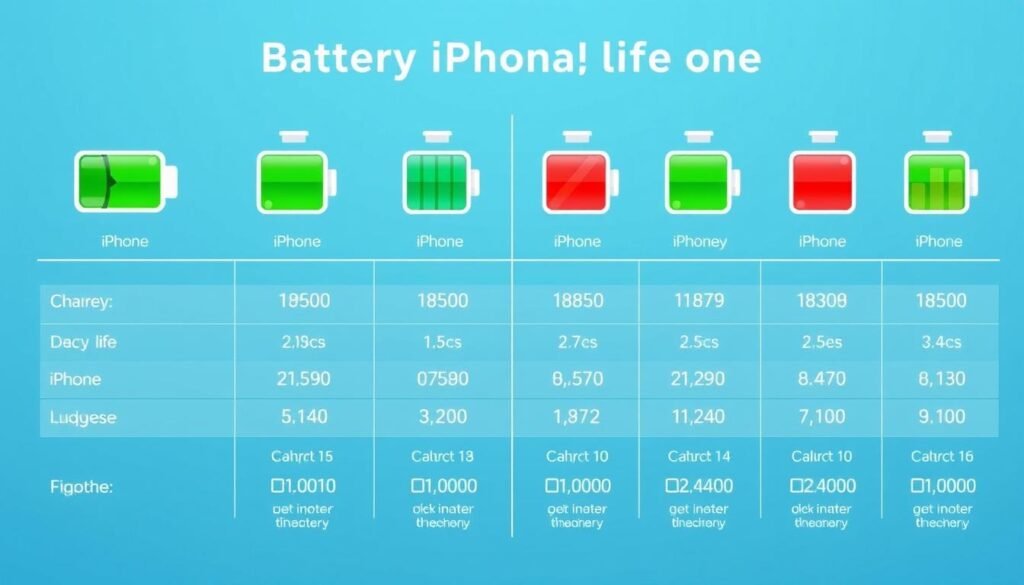
Since the iPhone 6 came out, Apple has improved battery technology. This includes managing performance to stop sudden shutdowns and updates to check battery health. The Battery Health tool gives clear info on battery life and care. This helps make smartphones last longer.
To sum up, iPhones are ahead in battery life and are important in advancing battery tech in phones today.
iPhone Software Updates and Ecosystem Integration
The iOS updates are key in shaping the iPhone ecosystem. The launch of iOS 18 brings new iPhone software features powered by Apple Intelligence. This update brings major improvements, making iPhones more personal and adaptable within Apple’s integrated environment.
The ecosystem integration is a big part of Apple’s approach. It lets iPhones, iPads, and Macs work seamlessly together. Thanks to features like AirDrop, AirPlay, and app continuity, users can share content and switch devices smoothly.
It’s important to understand the updates and upgrades in the Apple ecosystem. Regular software updates, like iOS 17.7, and major upgrades such as iOS 18 or macOS Ventura boost functionality and security. These updates include previous Rapid Security Responses (RSRs), keeping devices secure and up-to-date.
Here’s how to access these updates:
- Go to Settings > About > iOS Version on an iPhone or > About This Mac > More Info on a Mac.
- Hit the Info button next to the version to see and install RSRs or full updates.
Apple’s services like iCloud and Apple Pay make the user experience unified and easy to navigate. Using Apple Music to stream songs or syncing with an Apple Watch, the iPhone is a central part of this ecosystem.
“Apple’s ecosystem integration is more than functionality; it’s about a secure, cohesive environment that boosts performance and keeps users coming back.”
The easy connection between devices is not just for work but enhances lifestyle too. The way iPhone works with Apple Watch or AirPods makes communications and music listening smooth while on the move.
Though Apple’s ecosystem is highly praised, it’s sometimes seen as too closed. This could limit third-party developers and exclude non-Apple products. However, many users think the benefits of a seamless, secure system outweigh these issues.
With continuous updates like iOS 18, Apple aims to offer users a more personalized and integrated experience. This shows why so many stay loyal to iPhone, along with its family of devices and services.
How iPhone Wireless Capabilities Enhance User Experience
Advanced wireless features in iPhones have changed the game. Each new iPhone model boosts connectivity. This includes 5G and Wi-Fi 6 technology. These technologies improve internet speed and device syncing, making Apple services better for users.
From 5G to Wi-Fi 6: Connectivity Compared
Moving from 4G to 5G has been a big win for iPhone users. New iPhones support 5G, offering faster speeds and lower lag. Wi-Fi 6 in iPhones also brings quicker, more stable Wi-Fi for more devices at once without losing speed.
Apple’s Ecosystem: AirDrop, AirPlay, and Continuity
Apple’s ecosystem benefits from its devices working together smoothly. AirDrop and AirPlay make sharing files and media easy across devices. Continuity lets users switch between Apple devices seamlessly, keeping things like phone calls and copied text in sync.
| Feature | Description | Benefit |
|---|---|---|
| 5G Support | Enables faster data speeds and streamlined performance. | A quicker, more reliable connection enhances all online activities, from streaming to downloading large files. |
| Wi-Fi 6 | Latest Wi-Fi standard provides higher data rates and increased capacity. | Improves network efficiency and supports more devices simultaneously. |
| AirDrop | Quick and secure way to transfer files between Apple devices. | Streamlines work and personal file sharing with simplicity and speed. |
| AirPlay | Stream audio, video, device screens, and photos using Wi-Fi. | Integrates entertainment and presentation capabilities across Apple devices. |
| Continuity | Seamlessly move between Mac and iOS devices without losing your work. | Enhances productivity and device interoperability for a fluid user experience. |
iPhone Accessories: Enhancing Your Device’s Capabilities
Enhancing your iPhone with various add-ons boosts its performance and makes it more personal. Apple-certified accessories are compatible and safe. MagSafe technology adds ease and more utility.
The Impact of MagSafe Accessories
MagSafe technology has changed how we use iPhone accessories. With 47% of accessories using MagSafe, it’s easy to attach cases, chargers, and wallets. They attach magnetically, enhancing user experience and keeping the iPhone looking good.
iPhone MagSafe accessories provide strong protection and quick functionality enhancements. They allow for quick charging and easy attachment of wallets, improving ease and efficiency.
Choosing Protective Cases and Apple-certified Add-ons
It’s essential to protect your iPhone from damage. There are many cases available, from shock-absorbing to sleek designs. They protect your phone while showing your style. iPhone accessories have an average price of £72.17, but discounts can be up to 52%. Investing in good protective gear, like screen protectors, is smart.
With the European Union’s new rules for charging connectors, it’s important to choose Apple-certified accessories. USB-C compatible devices keep your iPhone up to standards and compatible.
Picking the right iPhone accessories can enhance your smartphone’s function and look. There are many chargers, cases, and essentials to explore. They help your iPhone match your lifestyle perfectly.
iPhone Cost-Benefit Analysis: Is the Latest Model Worth It?
When thinking about getting the latest iPhone, there’s more to consider than looks. We’ll look closely at whether it makes sense to buy the newest model. We compare features of different iPhone generations. We’ll discuss iPhone resale value, investing in a smartphone, and how well these devices keep their value.
Comparing Prices vs. Features of Different Generations
New iPhone releases usually mean better technology but at higher prices. For example, the iPhone 11 was released at $749 with an A13 Bionic chip and a two-camera system. But, the iPhone 14 Pro starts at $799, with even better A16 chip technology. This shows why it’s important to compare what you get for your money with each model.
Value Retention and Resale Value
Choosing Apple devices often means good resale value. The iPhone 11, for instance, keeps its value well because of its great features. These include a 6.1-inch Liquid Retina display and dual 12MP cameras. It also has night mode and can shoot 4K videos. This resale value is key for those who see their phone as an investment and plan on upgrading later.
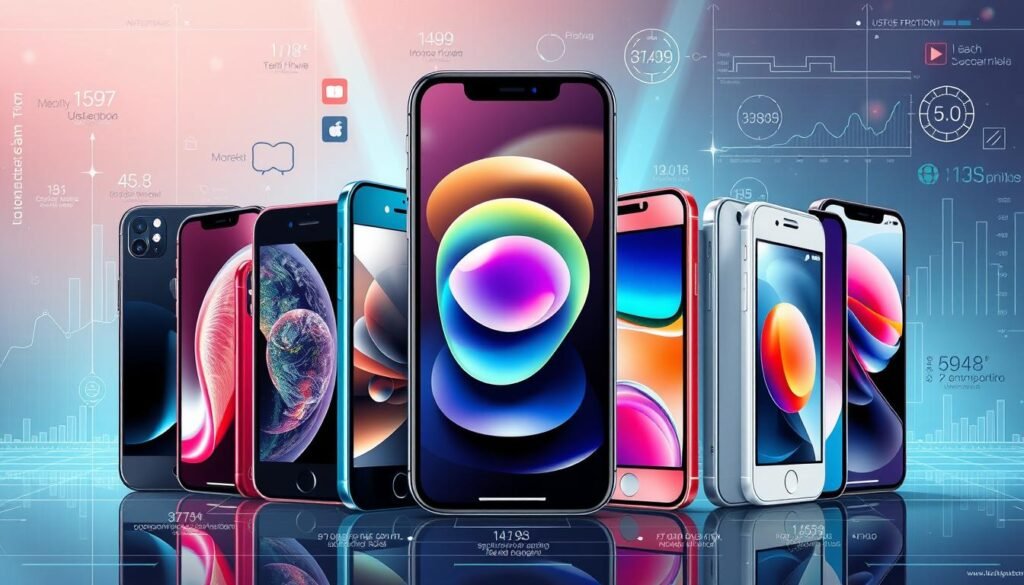
| Model | Release Year | Initial Price | Technology | Resale Value Estimation |
|---|---|---|---|---|
| iPhone 11 | 2024 | $749 | A13 Bionic chip, Dual Camera | High |
| iPhone 14 Pro | 2026 | $799-$999 | A16 chip, Advanced Camera Features | Very High |
| iPhone 15 Pro | 2027 | $999-$1499 | Enhanced A16 chip, Superior Display | Extremely High |
In summary, while the iPhone 14 Pro and 15 Pro offer cutting-edge features, the iPhone 11 remains a smart choice for those watching their budget. Choosing an iPhone means thinking about immediate benefits and future resale value. Every generation has its advantages, depending on your needs.
Conclusion
Reflecting on each iPhone model’s features is key. From the iPhone 11’s great camera and battery life to the iPhone 12’s display and design improvements. Choosing the right iPhone means understanding your own needs and likes. The iPhone buying guide we talked about shows how important it is to find a good balance. You want a phone that’s not just powerful but also keeps its value over time.
The iPhone 15 lineup offers excellent USB 3.0 transfer rates for the Pro model. Meanwhile, the iPhone 12 Pro Max shines with the highest battery capacity in its series. To get the most out of an iPhone, balance the features with how much you want to spend. Look closely at things like screen brightness and how much storage you get. This helps in picking the right model for a great user experience. For details on how we handle your data during this process, check our privacy policy.
Every new iPhone generation brings something special. Your choice might be influenced by the iPhone 12 mini’s portability or the iPhone 12 Pro’s advanced cameras. We’ve done a deep dive into each model’s best features in this article. The key is to find a phone that fits your lifestyle, thinking about how long it will last and its resale value. With careful decision-making, having an iPhone is not just about style. It’s about making a smart choice for tech lovers and everyday people too.





